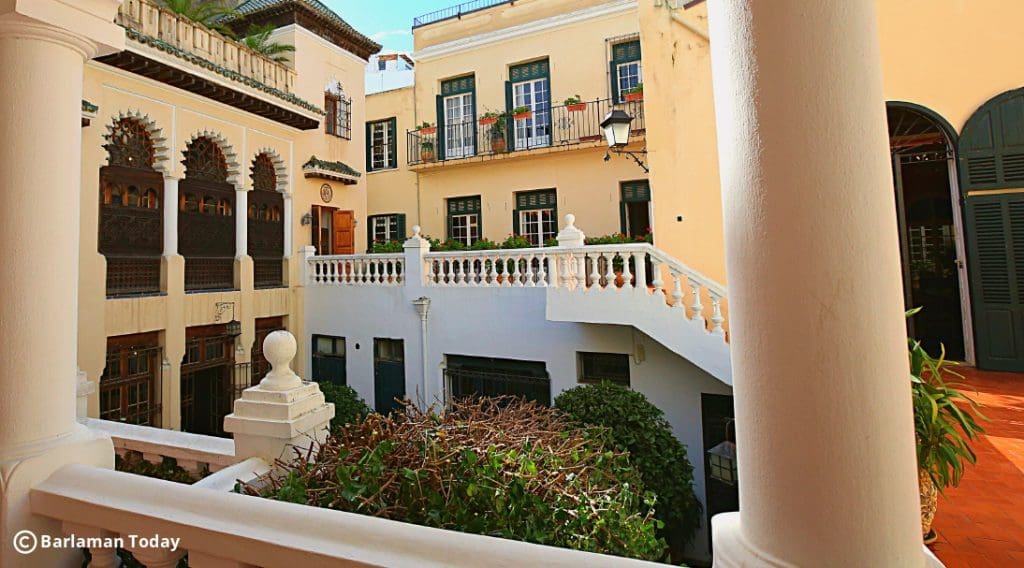Most people would probably think that the first U.S-owned property outside the U.S borders is in Europe or maybe in Asia. We could not be more wrong, as the longest-tenured American-owned property on a foreign territory is in the city of Tangier, Morocco, a melting pot for different cultures and nationalities.
The American legation is the only US national historic Landmark outside the United States and has served as a symbol of American engagement with Morocco since the early days of the Republic.
Morocco was the first country to recognize the American statehood in 1777. What is now known as the Tangier American Legation was gifted by Sultan Moulay Suleiman to the American government in 1821.
The former US consulate is located north of Tangier, in a sprawling compound that straddles both sides of Zanqat America in the section of the old medina known as Haoumat Béni-Idir. This multi-purpose research and cultural center includes a functioning museum, a library, offices, reception areas, and living quarters for the resident director of the Institute.
Starting 1961, the original building began its extension outside the medina. It had served as a US consulate, a legation, a State Department Foreign Service language school, and a Peace Corps training center. It has become a museum dedicated to displaying art and artifacts related to the Moroccan–American relations.
The Arab pavilion of the complex features art works, furnishings, books, maps and photographs telling tales of past international and domestic crises, espionage, and political intrigue. We are visiting a multi-story, labyrinthine building decorated with antique arches, patios, fountains, mosaic tiles, lanterns, carved doors, and wrought-iron gates, the result of significant renovations and property acquisition undertaken from 1927 to 1931 by Consul Maxwell Blake.
At the main entrance, we notice vivid pictures of bilateral conventions, a miniature reflection of the country’s past. The museum includes one of the most important documents exhibited at the legation, which is the letter sent in 1789 by President George Washington to Sultan Mohamed Ben Abdellah, in recognition of Morocco’s efforts and its signing of the 1787 Marrakesh Treaty, the first and oldest treaty between the USA and an Arab, Muslim and African country.
We proceeded to the WWII section where we were immersed in history just by viewing the paintings, the collectibles, the enigma machine…, and listening to the popular music of that era. We felt as if we were on the battlefield.
The American Legation Museum tells the story of cultures’ confluence and the long-standing, shared history of the USA and Morocco during WWII. Thus, visitors can understand the price of victory and freedom.
The building hosts the Office of Strategic Services (O.S.S.), which was founded to gather intelligence and offer military support during WWII. The majority of diplomatic activities were moved to Rabat after the World War II and the Legation continued to develop and increase its presence in the cosmopolitan Tangier.
A sizeable collection of English-language newspapers published in Tangier, dating back to 1883, and microfilm copies of a unique newspaper published in London and devoted to Morocco were also showcased. The gallery shows how Morocco was involved as a scene for negotiations and celebrated by American newspapers.
Moving from one hall to another, we could witness the museum’s exhibits as engravings and watercolors of Morocco in the eighteenth and nineteenth centuries. The Museum also includes a collection of 20th-century art, much of which was painted by Moroccan and European artists in Tangier, as renowned American writers Paul and Jane Bowles. Paul’s friends included many famous authors like Tennessee Williams and Truman Capote, who often visited Tangier during the international zone period.
Paul Bowles was also a passionate lover and composer of music, that’s why he recorded over 72 hours of Moroccan traditional, tribal and spiritual music in 1959. The exhibit also honored Paul’s works with Moroccan authors such as Mohamed Choukri and Mohammed Mrabet.
Mark Twain, Malcolm Forbes and many other American diplomats, artists and businessmen have walked the halls and rooms of this building.
The Legation also serves as the American Institute for Maghreb Studies which has centers in Morocco, Tunisia, and Algeria. It includes a library with over 8,000 books, monographs, theses, documents, and serials, dating from the seventeenth century to the present; and a conference center for professional meetings, scholarly gatherings, and a study center for researchers.


